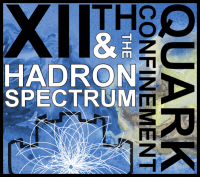Speaker
Description
The heavy-quark spin symmetry (HQSS) partners of the X(3872) molecule are investigated based on a chiral effective field theory (EFT) approach involving contact and one-pion exchange interactions. The integral equations of the Lippmann-Schwinger type are solved for a coupled-channel problem involving the $D\bar D, D\bar{D}^*$, and $D^*\bar{D}^*$ interactions to yield the scattering amplitudes with the quantum numbers $J^{PC}$=$1^{++}, 1^{+-}, 0^{++}$ and $2^{++}$. As a starting point, we confirm that, if the X(3872) were a $1^{++}$ $D\bar{D}^*$ molecular state, in the strict heavy-quark limit, it should have three partner states degenerate in the mass, with the quantum numbers $1^{+-}, 0^{++}$ and $2^{++}$. At first glance, in presence of pions, this result might look mysterious since pions relate heavy meson-antimeson pairs in various partial waves depending on the quantum numbers. It can be shown, however, that the integral equations can be brought to the block-diagonal form by appropriate unitary transformations, where one of the blocks appears to be the same for all quantum numbers, thus accounting for the degeneracy of the states. We stress that neglecting some of the coupled-channel transitions in an inconsistent manner leads to a severe violation of HQSS and yields regulator-dependent results for the partner states.
Deviations from the heavy-quark limit predictions are investigated for the $2^{++}$ partner state of the X(3872) in the EFT with nonperturbative pions. While going away from the strict heavy-quark limit suggests the presence of an additional (unknown) counter term for the $D^{(*)}\bar D^{(*)}$ scattering system in order to absorb the dependence of the results on the regulator, it is still possible to conclude that the spin-2 partner of the X(3872) acquires a significant shift of the mass as well as a width of the order of 50 MeV due to coupled channels governed by the nonperturbative pionic dynamics.




